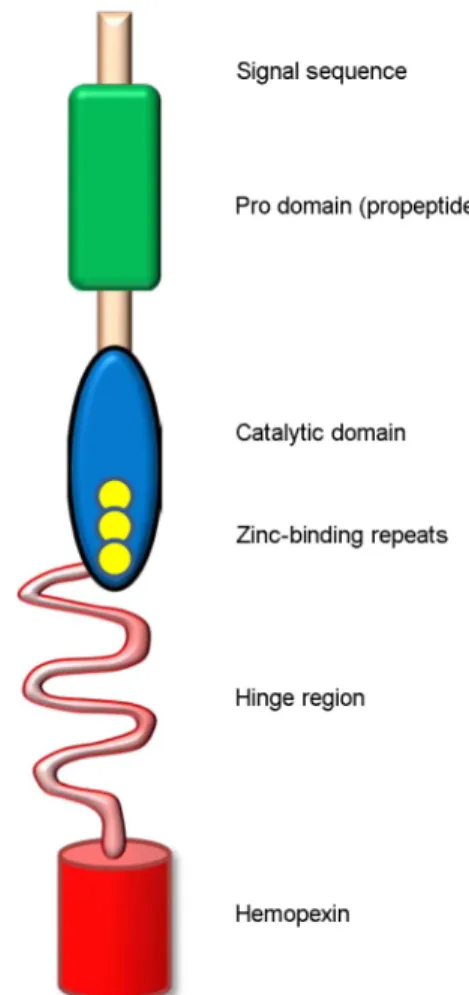Biomedical Science Letters 2014, 20(3): 103~110 http://dx.doi.org/10.15616/BSL.2014.20.3.103 eISSN : 2288-7415
Roles of Matrix Metalloproteinase-9 in Cancer Metastasis
Hyereen Kang 1 and Sung-Wuk Jang 1,2,†
1
Department of Biomedical Sciences, University of Ulsan College of Medicine, Seoul 138-736, Korea
2
Department of Biochemistry and Molecular Biology, University of Ulsan College of Medicine, Seoul 138-736, Korea
Matrix metalloproteinases (MMPs), also called matrixins, function in the extracellular environment of cells and degrade both matrix and non-matrix proteins. They are multidomain proteins and their activities are regulated by tissue inhibitor of metalloproteinases (TIMPs). The uncontrolled regulation of MMPs is involved in various pathologic processes, such as tumor invasion, migration, host immune escape, extravasation, angiogenesis, and tumor growth. Especially, matrix metalloproteinase-9 (MMP-9) is one of the metastasis-accelerating genes involved in metastasis of various types of human cancers. Here, we review the member of MMP family and discusses their domain structure and function, enzyme activation, the mechanism of inhibition by TIMPs. In particular, we focus the role of MMP-9 in relation to cancer metastasis.
Key Words: Extracellular proteinases, Matrix metallopproteinase-9, Metastasis, Invasion
INTRODUCTION
Metastasis is a complex series of steps in which cancer cells leave the original tumor site and migrate to other tissues of the body through the bloodstream or the lymphatic system (Nguyen and Massague, 2007). Cancer occurs after a single cell in a tissue is progressively genetically damaged to produce cells with uncontrolled proliferation. In general, malignant cells break away from the primary tumor and attach to and degrade proteins that form the surrounding extracellular matrix (ECM), which separates the tumor from neighboring tissues (Nguyen and Massague, 2007; Pantel and Brakenhoff, 2004). By degrading these proteins, cancer cells are able to breach the ECM and escape. Proteases of
the matrix metalloproteinase (MMP) family are involved in the breakdown of ECM in normal physiological processes, such as embryonic development, reproduction, angiogenesis, bone development, wound healing and cell migration, as well as in pathological processes, such as arthritis and metastasis (Van den Steen et al., 2002; Vandooren et al., 2013). Most MMPs are secreted as an inactive form which are activated when cleaved by extracellular proteinases.
MMP-9 plays a central role in tumor progression, including stromal remodeling, eventually metastasis, rheu- matoid arthritis, arteriosclerosis and angiogenesis (Farina and Mackay, 2014; Kupferman et al., 2000). MMPs such as MMP-9 are involved in the development of several human malignancies, as degradation of collagen IV in basement membrane and extracellular matrix facilitates tumor progression, including invasion, metastasis, growth and angiogenesis (Groblewska et al., 2012). The purpose of this review is to examine the role of MMP-9 in relation to cancer metastasis. The regulatory mechanisms controlling these enzymes will also be discussed, particularly the tissue inhibitors of metalloproteinase (TIMPs).
Review
*
Received: May 29, 2014 / Revised: August 19, 2014 Accepted: August 20, 2014
†

